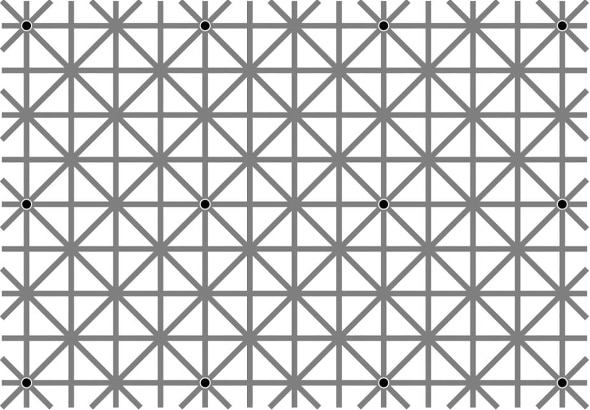Create a free profile to get unlimited access to exclusive videos, sweepstakes, and more!
This Illusion Knows When You Are Looking at It

Regular readers know I have a love of optical illusions, and I have a really freaky one for you once again.
The image above is from master illusion maker Akiyoshi Kitaoka. Take a look at it. It’s a pattern of intersecting vertical, horizontal, and diagonal lines, making a grid of sorts. In a regular pattern where the lines intersect Kitaoka has placed a black circle surrounded by a thin white ring.
Go ahead, focus on one of those circles. Notice anything?
Yeah. When you look at one circle, all (or most of) the others disappear! What the what?
I’ll note that all the images in this article are JPGs, so they’re not animated or anything like that. They are true illusions. Kitaoka calls this one the Ninio Extinction Illusion, after Jacques Ninio, who published a paper about it. It’s a variation of what’s called the Hermann grid illusion, which you may have seen before:
It’s just dark square tiles with white alleys in between. If you fix your gaze on one alley intersection, it looks white, but all the others look gray!
A variation on this is called the scintillating grid. At the places where the gray alleys intersect, small white circles are inserted, just touching the corners of the black tiles:
As you move your gaze around, small black circles seem to appear and disappear in the white circles everywhere except right where you’re looking, as if they know where you’re gazing. It makes the grid look like it’s flashing, or scintillating. It’s bizarre.
Kitaoka’s illusion takes this to the next step, separating the circles so they’re dispersed a bit more. When you look at one, it’s very difficult to see any others, as if they disappear when you don’t look at them (Schrödinger’s dots?).
So what causes this? It was first thought that it had to do with the way the grid fell on the retina in your eye, where cells called photoreceptors react to the light. However, other researchers have found that can’t be true, because changing the grid a bit destroys the illusion, even though the cells should react the same way. This has led them to believe the illusion happens in the brain itself, in the primary visual cortex located in the back of the brain. However, it’s still not clear what sort of misfiring is going on that tricks your brain into thinking the dots are appearing and disappearing.
So even though this illusion is simple in setup, why it actually works is something of a mystery. How about that?
And of course, I love it when that happens. Our brains are so easy to fool: We see colors that aren’t there, patterns that aren’t there, motion that isn’t there, faces that aren’t there, hear sounds that aren’t there. It’s a testament to the slapdash nature of evolution. Our brains weren’t designed; they accumulated over millions of years, adjusting here and there as circumstances and natural selection warranted. What we have now sitting in our skulls isn’t so much a finely tuned computer as a seriously jerry-rigged Rube Goldberg machine.
Always remember that when someone claims they saw a UFO or a ghost, and swear they know what they saw. Because the odds are really, really good they don’t.
Tip o’ the parafoveal vision to my friend Tracy King.














